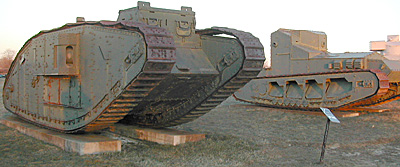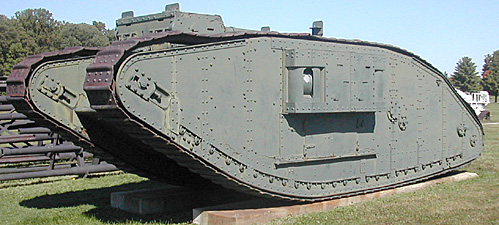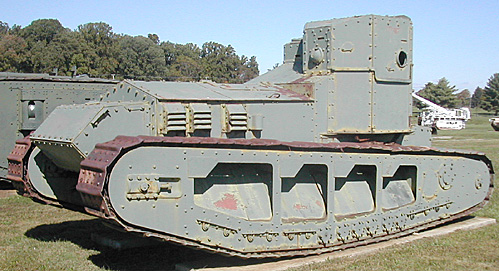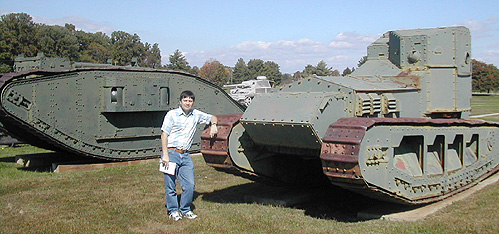Mk IV (left) and Whippet (right)

Mk IV from the other side.

Whippet from the other side. Note that the front points to the left. The pentagon-shaped box between the treatds holds the gas tank.

Short History of the Mk IV
At a September 29 conference chaired by Lt. Col Ernest Swinton, the Lanships Committee released specifications calling for 10mm of armor in the front, 8mm on the side, and 6mm on top. The crew would be eight men, the speed increased to 4mph, and 6 pounder (57mm) guns would be the main armament. Production of the two prototypes continued. On Christmas Eve, another conference set up organizational responsibilities.
By January 1916, the prototypes were finished, and on the 16th, "Big Willie" ran on its own tracks for the first time. On the 29th, Tritton, Wilson, and company conducted the first preliminary trials on a "steeplechase" course. "Big Willie," at 31 feet 3 inches long, 8 feet high, and 13 feet 8 inches wide, crossed parapets, trenches, marshy ground, and barbed wire entanglements without a hitch. The eight man crew consisted of a commander (1), gear changer (1), driver for each track (2), and two gunners for each sponson (4).
On February 2, 1916, the tank was officially presented to War Minister Lord Kitchener, Minister of Munitions Lloyd George, First Lord of the Admiralty Arthur Balfour (Churchill's successor), Chancellor of the Exchequer R. McKenna, now Rear Admiral Sir Murray Sueter, a number of generals, and others. This trial was also a success, including an impromptu demonstration of the tank crossing a 9-foot wide trench instead of the official requirements of crossing a five foot wide trench. Although Kitchener dubbed it a "a pretty mechanical toy," the others were most impressed, including Sir William Robertson, Chief of the Imperial General Staff. Balfour insisted on going for a ride. Sueter remarked, "we ought to order 3,000 at once."
On the 8th, the King visited for a demonstration, went for a ride, and declared "it would be a great asset to the Army possessing a large number [of tanks]." However, when the paperwork went through on February 11, 1916, only 40 of the machines were ordered. Swinton, however, argued for 100, which the Army Council accepted and George signed the paperwork, with 25 machines to be produced by Foster and 75 by Metropolitan Carriage. The Tank Supply Committee was formally inserted on the organization chart under the Ministry of Munitions. "Big Willie" received a new official designation, the Mark I, while the original prototype earned the nickname "Mother."
In April 1916, Swinton argued that the "Destroyer" tank needed defensive firepower, as the 6 pounders were ineffective in that role. He proposed a "Man Killing" tank to be armed with four Vickers machine guns (two in each sponson) instead of the 6 pounders. These new tanks were dubbed the "female" version, while the original 6 pounder version was dubbed "male." George agreed and the order was increased to 150 tanks, half female and half male.
Although the Mark I design was relatively sound, battlefield experience soon set the designers the challenge of modifying the design enough to overcome shortcomings.
The tail, or tailwheel, was discarded. Whatever its advantage in crossing wider trenches, it didn't help steering that much and was prone to breakage and shell fire. Armor thickness was increased to 12mm in the front. The sponsons were too wide, especially for rail transit when they had to be removed, so they were made smaller and a mechanism created to push them inside the tank for transit. Escape hatches were redesigned to make it easier for a crew to leave a disabled tank. Machine guns were added to the male models so it would have its own infantry fire support. The petrol supply was moved from the middle inside of the tank to the outside rear of the tank to reduce the risk of fire. The exhaust which opened on the roof and attracted attention at night was elongated downward and to the rear. The suspension and tracks were strengthened. The glass prisms, which had a nasty habit of shattering and blinding the drivers during combat, were replaced with steel plate and pinhole perferations. The armor was better distributed to protect vital systems. Maximum speed remained 3.7mph. All of these features would go into the next standard model: Mark IV.
Since ditching was a big problem, a couple of wooden spars (later steel beams) attached to the tracks by chains served as an improvised extrication device. It could be unclipped from the roof and attached in minutes. The spars would slowly make their way across the top of the tank, around the front, and then underneath, pulling the tank loose from most holes.
MagWeb's Russ Lockwood hopes he doesn't need a tetanus shot after leaning on the Whippet.

Short History of the Whippet
Cambrai had shown the potential of the tank, and the Mark IV had performed admirably. But the British would produce a new heavy tank, the Mark V, and a light tank, the Whippet. The Mark V was similar in size and shape to the Mark IV, but included a larger 150hp engine (vs. the 105hp engine of the Mark I and IV) to increase speed to 4.6mph, thicker armor in front (14mm vs. Mark IV's 12mm), and new epicyclic gearing designed by Wilson so it could be driven and steered by one man instead of three. The range was also slightly increased to 45 miles, from 35 miles of the Mark IV. On the downside, the radiator was moved inside the tank to the detriment of the crew as it reduced ventilation.
The Whippet was the so-called "Cavalry" or "Chaser" tank, designed by Tritton in December 1916 to exploit breaches in the enemy line made by Mark IVs and Vs. It could speed its four machine guns along at 8mph, carried 14mm armor in front, and possessed a range of 80 miles. One disadvantage was that untrained drivers would frequently stall out, as the vehicle had two engines (one for each track) and steering was by varying the engine speed. Unlike the Mark I through V, the Whippet's tracks did not go around the hull, but were self contained in a chassis. The engine and fighting compartments were attached to this chassis, making it a forerunner of the modern tank.
Aberdeen Museum and Tank Park
- Overview of APG Museum and Tank Park
History of APG
Inside the Museum
- German Schwimmwagen
French 75mm Model 1897 Artillery
German Kubelwagen
Chinese 120mm Mortar
WWII German Granatwerfer 36 Grenade Launcher, German WWI 1916 Mortar
German MGs WWI and WWII
Israeli Uzi
Soviet PPSh41 "Burp Gun"
El Emulo Spanish 12lber Cannon
French WWII Renault R-35 Tank
German Goliath B1
Japanese 7.7mm Heavy Machine Gun
WWII Grenades
WWII Anti-Tank Shells
Nordenfelt Machine Gun
Tank and Artillery Park
- WWI British
WWII German
- German PzI Tank
German Pz 35 (t) Tank
German PzIII Tank
German PzIV Tank
German PzV Panther Tank
German 88mm AT Gun
German JagdPz IV Tank Destroyer
German JagdPz V Jagdpanther Tank Destroyer
German JagdPz VI Jagdtiger Tank Destroyer
German Grille Self-Propelled Artillery
German Hetzer Tank Destroyer
German Heuschrecke 10 Light Howitzer
German Marder II and III Tank Destroyer
German Nashorn Tank Destroyer
German Sturmpanzer IV Brummbar
German StuG III Assault Gun
German 37mm Flak 43 AA Gun
German 128mm Flak 40 AA Gun
German "Anzio Annie" [Leopold] RR Gun
WWII USA
- US M20 Armored Car
US M3 Half Track (M16 variant with quad 50s)
US Twin 40mm AA
US M3 Lee (Grant) Tank
US 8" Artillery
WWII Japanese
WWII Italian
WWII Soviet
- Soviet T-34 Tank
Soviet T-34/85 Tank
Soviet SU-76 Assault Gun
Soviet SU-100 Assault Gun
Soviet IS-3 Iosef Stalin Tank
WWII British
WWII French
Post War
Other
Back to List of Historic Sites
Back to Travel Master List
Back to MagWeb Master List of Magazines
© Copyright 2004 by Coalition Web, Inc.
This article appears in MagWeb.com (Magazine Web) on the Internet World Wide Web.
Other articles covering military history and related topics are available at http://www.magweb.com